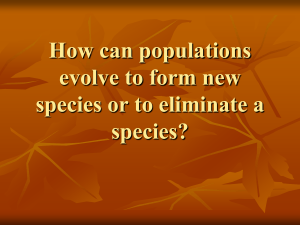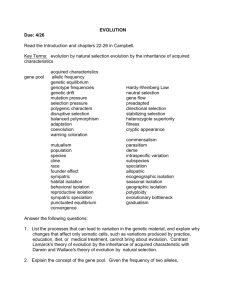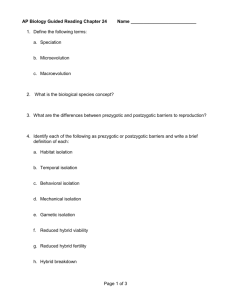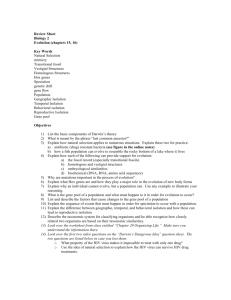5/31/2012 1 Speciation and macroevolution - Chapter
advertisement
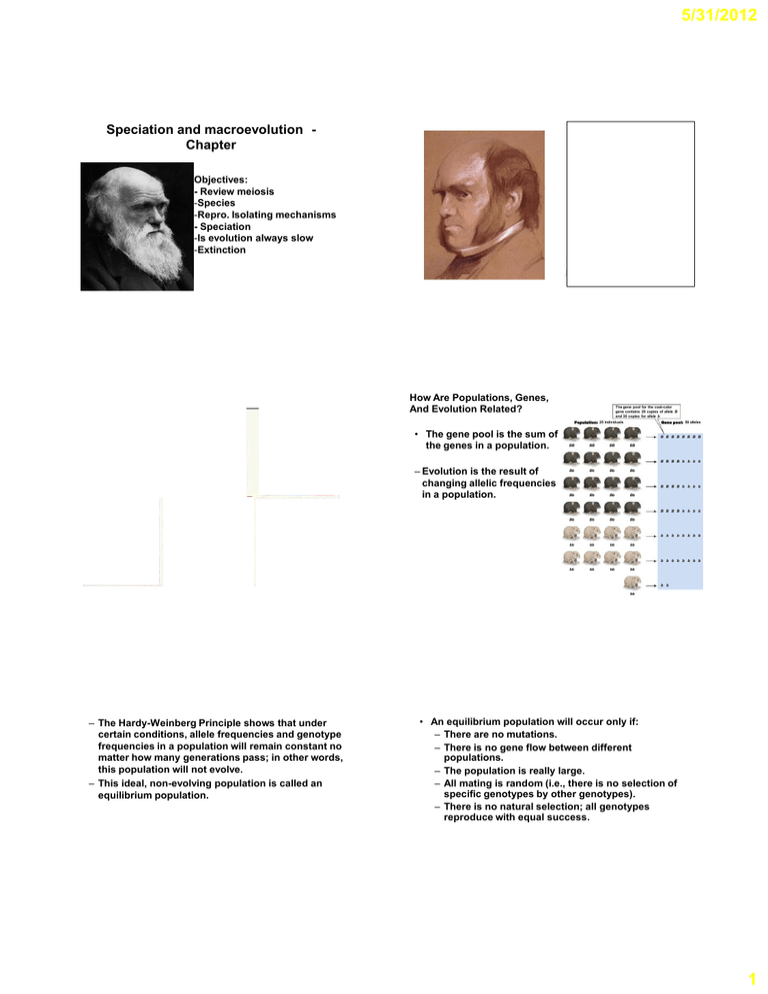
5/31/2012 Speciation and macroevolution Chapter Objectives: - Review meiosis -Species -Repro. Isolating mechanisms - Speciation -Is evolution always slow -Extinction How Are Populations, Genes, And Evolution Related? The gene pool for the coat-color gene contains 20 copies of allele B and 30 copies for allele b Population: 25 individuals • The gene pool is the sum of the genes in a population. Gene pool: 50 alleles B B B B B B B B BB BB BB BB Bb Bb Bb Bb Bb Bb Bb Bb Bb Bb Bb Bb bb bb bb bb bb bb bb bb B B B B b b b b – Evolution is the result of changing allelic frequencies in a population. B B B B b b b b B B B B b b b b b b b b b b b b b b b b b b b b b b bb – The Hardy-Weinberg Principle shows that under certain conditions, allele frequencies and genotype frequencies in a population will remain constant no matter how many generations pass; in other words, this population will not evolve. – This ideal, non-evolving population is called an equilibrium population. • An equilibrium population will occur only if: – There are no mutations. – There is no gene flow between different populations. – The population is really large. – All mating is random (i.e., there is no selection of specific genotypes by other genotypes). – There is no natural selection; all genotypes reproduce with equal success. 1 5/31/2012 What Causes Evolution? What Causes Evolution? • Mutations are the original source of genetic variability in a population. – An unrepaired mutation in a nucleotide sequence in DNA occurs rarely – that change is passed on to gametes – shows up in the offspring (providing increased diversity to the gene pool) • Mutation provides a potential for evolutionary change. • It is not goal oriented (mutation doesn’t know what environment will be working on it) • What if by chance . . . BB BB BB BB Bb Bb Bb Bb Bb Bb Bb Bb Bb Bb bb bb bb bb bb – http://upload.wikimedia.org/wikipedia/commons/b/b 6/Random_sampling_genetic_drift.gif • Population bottlenecks cause genetic drift • Reduce variation!! (Cheetas!) . BB • Genetic drift – Chance random events cause allelic frequencies to change. – Can occur in small populations. • A disaster reduces an allelic frequency • Isolation of a breeding group (can’t pass on alleles) • Disease frequency of B = 50% frequency of b = 50% Population size matters. - If a population is sufficiently large, chance events are unlikely to alter allelic frequencies much. - In a small population, a particular allele may be carried by only a few organisms; chance events could eliminate most or all examples of such an allele from the population. What Causes Evolution? • A founding population has a different allelic frequency – From a bottleneck event – From a small break away population The gene pool of a population contains equal numbers of red, blue, yellow and green alleles A bottleneck event drastically reduces the size of the population By chance, the gene pool of the reduced population contains mostly blue and a few yellow alleles After the population grows and returns to its original size, blue alleles predominate; red and green alleles have disappeared Don’t forget!!!! • Natural selection stems from unequal reproduction (i.e., differential reproductive success) – Natural selection works on individuals, but its populations that change by evolution – Natural selection works through those individuals in a population that leave the most offspring that carry alleles that were selected by the environment. – Natural selection does not act directly on the genotype of an organism but on its phenotype – Evolution does not make organisms “better.” So what does the term”survival of the fittest” mean? 2 5/31/2012 Species (Biological Species Concept) A group of organisms with similar structural and functional characteristics that in nature breed only with each other and have a close common ancestry - a common gene pool (isolated from others) - restricted by reproductive barriers Species and reproductive isolation Problems with concept: 1. What about asexual organisms? 2. What about when two species interbreed and produce an offspring? • lion + tiger = “liger” (sterile) • female horse + male donkey = mule 1. Temporal Isolation Reproductive isolating mechanisms - genetic integrity is maintained Premating barriers interfere with mating! They are premating!! 1. Temporal isolation 2. Behavioral (sexual) isolation 3. Mechanical isolation 4. Habitat isolation & Geographic isolation 2. Behavioral Isolation 3. Mechanical Isolation 3 5/31/2012 4. Habitat isolation & Geographic isolation •Closey related species that occur in different habitats or vastly separated areas geographically Species and reproductive isolation Postmating barriers prevent successful reproduction when mating does occur: 1. Hybrid inviability: (embryonic hybrid dies) 2. Hybrid sterilty: (hybrid is infertile - no gametes) 3. Hybrid breakdown = F2 Hybrid has defect: F1hybrid Okay but offspring doesn’t reproduce well 4 Gamete incompatability: gamete doesn’t fertilize egg at all Hybrid Sterility The key to speciation is reproductive isolation. Speciation: The evolution of a new species. Female horse Mule (Sterile) 1. Geographical separation can lead to a new species Male donkey 2. - Long physical isolation - Different selective pressures Kaibab squirrel?? 4 5/31/2012 Sypatric Speciation: • Allopolyploidy: (Plants) Multiple sets of chromosomes from > 2 spp. Hybrid • Changing ecology (fruit maggot flies in Hudson River valley) Species A 2n = 6 Species B 2n = 4 P generation Polyploidy n= 3 n= 2 Gametes Hybrid AB F1 generation No doubling of chromosome number Doubling of chromosome number 2n = 10 Chromosomes either cannot pair or go through erratic meiosis No gametes or sterile gametes-no sexual reproduction possible Pairing now possible during meiosis n= 5 Viable gametes-sexual reproduction possible (self-fertilization) Slide 3 Is evolutionary change fast or slow? They eat, mate, and lay eggs on different hosts • Darwin’s view predicts slow gradual change? • Does the fossil record support this? Hawthorne maggot fly range (parasitic on native hawthorne) Apple maggot fly and Hawthorn maggot fly range (parasitic on domestic apples) Slide 5 5 5/31/2012 Macroevolution: Large scale phenotypic changes - radical changes that create new species Driving forces behind macroevolutionary changes? 1. Evolutionary novelties? 2. Adaptive radiation? 2. Mass extinction? 1. Evolutionary novelties Evolution works on existing things (its conservative) Pre-adaptations: variations on a pre-existing structure - originally filled one role – changed in a way to become adaptive for a different role - feathers? Scales (protection/insulation) to insulation/flight How might such a novelty occur? - mutation in a gene? - e.g. Developmental gene – that regulates development of an organism mutated Mutation of a developmental gene - Axolotl salamander: mutation prevented maturation • Remember evolution is conservative Paedomorphosis 2. Adaptive radiation • The evolution of many related species from an ancestral species a b c d e z - adaptive zones (ecological niches) 6 5/31/2012 3. Extinction!!!!!!!!!!!!! Is the process of extinction evolution? Background vs. Mass extinction 6th Great Extinction! 7

